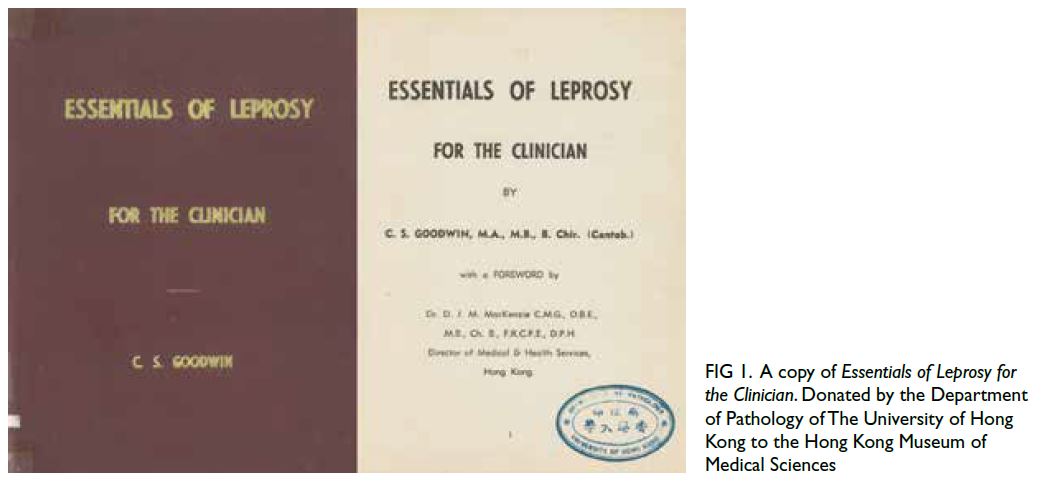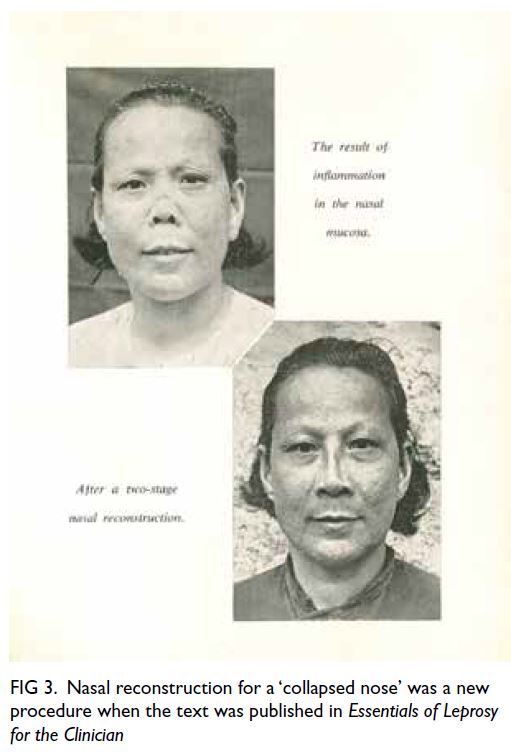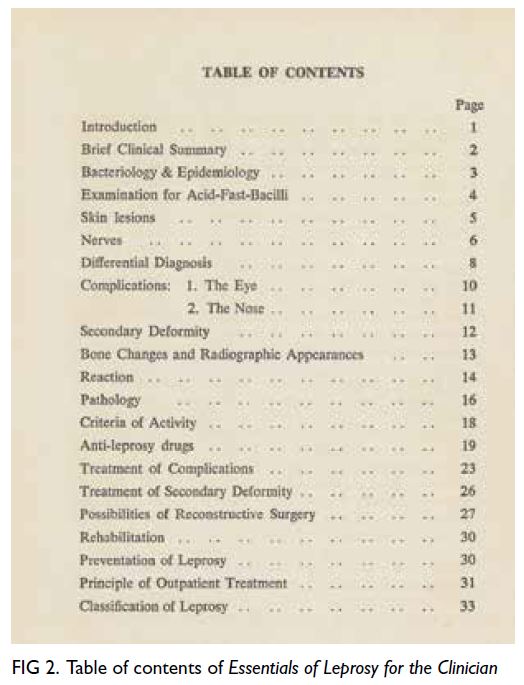© Hong Kong Academy of Medicine. CC BY-NC-ND 4.0
REMINISCENCE: ARTEFACTS FROM THE HONG KONG MUSEUM OF MEDICAL SCIENCES
A synopsis of leprosy for medical students in
Hong Kong
TW Wong, FHKAM (Emergency Medicine)
Member, Education and Research Committee, Hong Kong Museum of Medical Sciences Society
The incidence of leprosy has decreased significantly
in Hong Kong since the 1970s,1 and medical students
today will have little exposure to this once-dreaded
disease. Leprosy has been described in ancient
Chinese medical texts for centuries, but it was
during the Ming and Qing dynasties that it became
a highly feared and stigmatised condition due to
the deformities and purported contagiousness.2
Although the pathogen Mycobacterium leprae was
discovered in 1873, it took many years to educate
both doctors and the public about the true nature of
the disease. Dr James Cantlie, one of the founders of
the Hong Kong College of Medicine, was the first to
study patients with leprosy who presented to the Alice
Memorial Hospital.3 In 19th-century Hong Kong,
those with leprosy, whether residents or immigrants,
were not welcome and would be repatriated to
mainland China by persuasion or force. In the Lepers
Ordinance of 1910, it was decreed that all lepers in
the Colony, once identified, would either be deported
or segregated to Kennedy Town Infectious Disease
Hospital by the police. Compulsory segregation
was lifted by later legislation (the Lepers Ordinance
of 1935) and treatment by private practitioners or
outpatient clinics was allowed if deemed medically
suitable.4 Chinese patients would be sent to a
leper asylum operated by Catholic missionaries in Sheklong (石龍), which received financial support
from the government.2
After the Second World War, there was a huge
influx of people, including those with leprosy. With
the closure of the border, it was no longer feasible to
send such patients to the asylum in China. To assist
with this situation, the Mission to Lepers, with the
support of the government and local community,
raised funds to establish a leprosarium in Hay Ling
Chau in 1951. It was comprised of dormitories
for patients, a medical centre, and rehabilitation
facilities, and had a maximum occupancy of 540.5
The Mission to Lepers was an international and
interdenominational Protestant organisation
founded in 1874 in London; the Hong Kong Auxiliary
was formed in 1950. The Mission and its Auxiliaries
aimed to provide care and treatment to patients with
leprosy and eradicate erroneous fears and prejudices
of the public.6
The teaching of medical students in Hay Ling
Chau was started by Dr HJ Smyly in 1954. The Mission
believed that enlightened doctors and nurses would
lead the way in educating the public and hopefully
remove the stigma around patients with leprosy.
Initially, a small group of medical students would
come for a week, rotating monthly. By 1962, a large
group would also attend every 3 months for a day of lectures and demonstrations.6 A new set of notes for such students was created under the title of Essentials
of Leprosy for the Clinician. It was written by Dr CS
Goodwin, the Acting Medical Superintendent of the
Hay Ling Chau Leprosarium (Fig 1). The Director
of Medical and Health Services of Hong Kong, Dr
DJM Mackenzie, provided the following comments
in the foreword: ‘It now remains for the community
to welcome back the cured and restored leprosy
patients and, in this the clinician has a significant
part to play in winning social acceptance for them.’7
The text covered the gamut, from basic sciences
to the clinical management of leprosy (Fig 2), and
contained several clinical photographs (Fig 3). At the time, the mainstay of leprosy treatment was the
use of sulphone drugs, particularly diaminodiphenyl
sulphone; surgical operations were also available to
correct deformities in suitable patients.

Figure 1. A copy of Essentials of Leprosy for the Clinician. Donated by the Department of Pathology of The University of Hong Kong to the Hong Kong Museum of Medical Sciences

Figure 3. Nasal reconstruction for a ‘collapsed nose’ was a new procedure when the text was published in Essentials of Leprosy for the Clinician
The Lepers Ordinance was finally repealed in
1965, removing any legal basis for the segregation of
leprosy patients. As the incidence of leprosy in Hong
Kong was steadily declining, the government decided
in 1971 that the Hay Ling Chau Leprosarium should
be phased out. It was permanently closed in January
1975 and the remaining patients were transferred to
the Lai Chi Kok Hospital. Those with leprosy also
continued to be seen at the Social Hygiene Service
leprosy clinics of the Department of Health.
References
1. Ho CK, Lo KK. Epidemiology of leprosy and response to treatment in Hong Kong. Hong Kong Med J 2006;12:174-9.
2. Leung AK. Leprosy in China: A History. New York: Columbia University Press; 2009. Crossref
3. Cantlie J. Leprosy in Hongkong. Hong Kong: Kelly & Walsh; 1890.
4. Smith NL, Wellington AR, Lo MK, Li C. Report of the Committee on Lepers, Sessional Papers Laid Before The Legislative Council of Hong Kong; 1935.
5. Skinsnes OK, Fraser ND. The design of a leprosarium (Hay Ling Chau, Hong Kong). Int J Lepr Other Mycobact Dis 1969;37:183-93.
6. Leprosy Mission Hong Kong Auxiliary. Leprosy Mission Hong Kong Auxiliary Hay Ling Chau Leprosarium Annual Report; 1962.
7. Goodwin CS. Essentials of Leprosy for the Clinician. London: Hong Kong Auxiliary of the Mission to Lepers (London); 1963.


